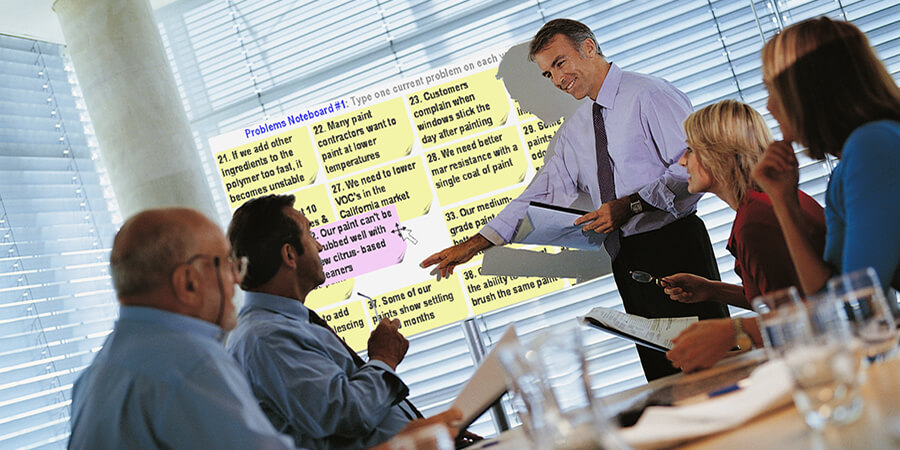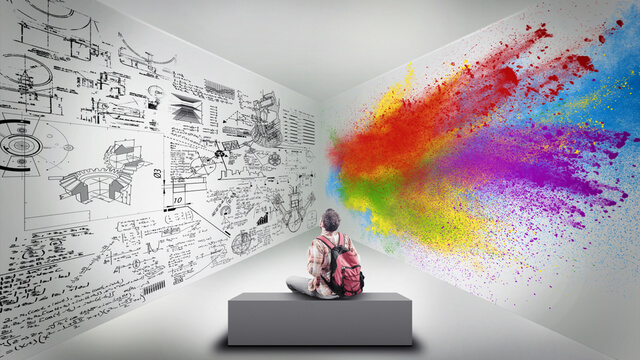For the Best Results, Project your VoC Notes

Why should you project your VoC notes?
Projecting VoC notes is critical. Why? At AIM, we’ve spent years exploring how B2B suppliers can best uncover the deepest needs of their customers—the first step to developing great new products. This journey has helped us develop new approaches to probing, advanced observation methods during customer tours, and trigger maps to stimulate fresh “out-of-the-box” customer thinking.
If your company supplies businesses, your customers are highly knowledgeable, rational in their decision-making, and often quite interested in what you can do to help them. It’s great that your customers are smart, sensible, and sympathetic… but not so great if you can’t take advantage of these characteristics.
The best way to hear the voice of your B2B customer is to let them see your notes.
Projecting VoC Notes Improve Our Learning and Engagement
Your voice of the customer tools should help you to learn better within the precious moments that you have for your interview. The best way is to let them see your notes on a projection screen as you’re taking them. Here are five tips when using a digital projector during your interviews, ranging from the practical to the psychological.
Let’s start with the practical:
Reason 1: Benefit from Real-time Correction
When our clients conduct qualitative customer interviews (which we call discovery interviews), they use a moderator to ask probing questions and a note-taker to record customer responses… which are digitally projected on a screen or wall. The customer is invited to speak up if any of these notes need to be changed.
Is this better than sending your notes to the customer later and asking for revisions? Absolutely. After the meeting, the customer’s attention has turned to other matters… and the supplier loses the opportunity to ask clarifying follow-up questions. What’s more, customers can tell when the supplier “gets it,” and this builds their confidence during the interview. When all are viewing the VoC notes, we improve our effectiveness by confirming outcomes with the customer.

Reason 2: Idea “Springboarding”
During discovery interviews, our clients project their notes (using Blueprinter® software) in digital “sticky notes” that look like 3M Post-It® Notes. You wouldn’t have to do this, but it makes customers feel as though they are in an idea generation or “brainstorming” mode.
A brainstorming session with just one person would be like playing handball in an empty parking lot.
One of Alex Osborn’s original brainstorming rules was to “build off others’ ideas” …which is why we like to interview several customer contacts at the same time. A brainstorming session with just one person would be like playing handball in an empty parking lot.
Click here to learn how VoC Tools can further ensure a great customer interview
You’ve probably been in many brainstorming sessions before: If a facilitator just jotted your group’s ideas on his/her notepad, wouldn’t it be hard to springboard off of—or even remember—the ideas? But if you can easily see all the ideas, you can review them, mull over them, connect them in unique ways, and build on them. Projecting the VoC notes maximizes what we can learn per minute – by transforming the interview into a brainstorming session.
Reason 3: Customer Prioritization
A good discovery interview typically results in dozens of customer-generated ideas… or more accurately, desired outcomes or end results customers would like to see. But not all of these outcomes are equally important in the customer’s view.
When you project your notes, it’s an easy matter to let the customers pick their favorites. In Blueprinting jargon, we call their favorite ideas “Top Picks,” and we ask customers to help us drag the sticky notes containing these outcomes to the top of the digital display. This would be tough to do if the supplier had recorded all these outcomes on his/her laptop or legal pad.
When all the customer contacts in the room can see these notes at the same time, they’ll discuss and debate which the most important are. The projector keeps the conversation focused on the VoC notes during these conversations.
Reason 4: No Transcribing VoC Notes Later
After a fine layer of dust had formed on the tube, the VoC notes were eventually transcribed.
Have you ever been in a brainstorming session where real sticky notes were stuck onto several sheets of flip-chart paper? At the end of the meeting, someone carefully rolled these sheets into a “bazooka tube” and marched off looking for an unsuspecting person to type the notes. After a fine layer of dust had formed on the tube, the notes were eventually transcribed and distributed to the participants, some of whom vaguely recollected the meeting.

It can be much easier than this. If you’ve created your notes digitally, all you need to do is spend a little time with your colleagues in a coffee shop right after the customer meeting. Clean up your typos, clarify some thoughts, expand others, and you’re on your way.
And don’t bother with a tape recorder. Not only will you jeopardize a respectful peer-to-peer discussion, you’ll create needless transcribing work for someone. A consumer-goods producer may need to “analyze” something an end consumer said that they didn’t understand. Your B2B customers are smart, so just ask them during the interview!
Reason 5: Customer Engagement
I’ve saved the most important reason to project VoC notes for last. I’m not a psychologist and I don’t claim to fully understand this… but we’ve observed the same behavior over and over, so let me describe it: Usually five to ten minutes into our interviews, customers get very engaged… often even leaning forward physically. In many cases, interviews that were scheduled for two hours last three, four, five, or even six hours!
Perhaps this is because customers see their ideas treated so respectfully: After all, how often does someone listen carefully to you, ask you intelligent questions about your ideas, record your thoughts for all to see, and keep checking to make sure they’re hearing you correctly? Right. It doesn’t happen to me either.
This is no longer the supplier’s show… it’s the customer’s show.
But here’s my favorite theory: This interview isn’t the supplier’s show… it’s the customer’s show. In traditional customer interviews, the supplier asks his questions one by one, and the customer reacts. Imagine you’re the customer in a Blueprinting discovery interview. You’re looking at a projection screen with a bunch of blank sticky notes, and the supplier is asking, “What else would you like to see in your ideal world?”
You realize the supplier isn’t working off his script or agenda. In fact, the supplier has absolutely no idea what you’re going to say next. He’s just facilitating. So instead of the customer helping the supplier fill in his questionnaire, the supplier is helping the customer speak his mind. In turn, the projector has transformed the session. It’s clearly a customer-led interview, not a supplier-led interview.
Employing the Digital Projector for viewing VoC Notes
So what does this mean for your company? Should you always use a digital projector when you’re trying to understand customers’ needs? No, sometimes it isn’t practical. If your customer is a chef in a restaurant, a mechanic in a garage, or a builder on a job site, you may not be able to use a projector.
But use a projector whenever you can, because it will help you substantially elevate the conversation. Sometimes this might mean scheduling an interview in a hotel conference room after work hours. Or it might mean getting creative: One of our clients noticed an empty construction trailer on a job site. He dragged an extension cord into the trailer, pulled some blueprints out of a trash can and taped them on the wall—white side out—and had a great interview.
In the battle to deliver more value to customers than your competitors, it all starts with understanding what customers value. Also, consider what software that you’ll use to take VoC notes for the interview. Blueprinter® software is designed for just this purpose.
Get Started with Better VoC Notes today!
If you’d like to learn more about highly engaging B2B interviews, download chapters 8 and 11 from The Book on Blueprinting — both are free downloads. If you’d like a short, private web-conference to learn how we train companies like yours in these skills, contact us for a free consultation.
Comments